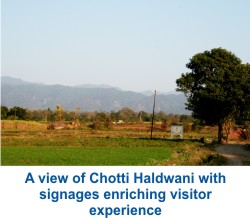Small is Beautiful
According to the International Eco-Tourism Society, “Eco Tourism is responsible travel to natural areas that conserves the environment and sustains the well being of local people.”
World Tourism Organisation defines tourism as involving travelling to relatively undisturbed areas with the specified object of studying, admiring and enjoying the scenery and its wild plants and animals, as well as any existing cultural aspects [both of the past or the present] found in the areas.
Eco-tourism as an activity covers the entire spectrum of initiatives from small scale, locally owned and managed initiatives to large corporate tourist industry setups. The sector has developed into various spheres like natural, cultural, community-based tourism, rural tourism, village tourism, responsible tourism etc. The growth of tourism in general has also expanded the envelope for tourists seeking authentic natural and cultural experiences.
In the late eighties, eco-tourism evolved as a
strategy to make conservation compatible with development in ecologically
sensitive areas. With the potential to generate economic benefits l ocally,
ecotourism emerged as a good incentive for conservation by all stakeholders.
ocally,
ecotourism emerged as a good incentive for conservation by all stakeholders.
This, coupled with environmental awareness, better transport facilities, has allowed people to travel further, seek new experiences in holidays, be it staying with local people in developing countries to adventure sports in some of the world’s most remote and wild areas.
As a business proposition however, eco-tourism is a high-risk activity vulnerable to marked seasonality, high staff to client ratios and need for specialised marketing. Like any other activity, especially one involved in exposure to vulnerable communities, ecosystems and habitats; eco-tourism raises legitimate concerns on the need to balance profits with conservation. Unplanned and unregulated tourism growth in natural areas can lead to pronounced negative environmental and cultural impacts.
In 2002, my involvement in the WII and US FWS Interpretation collaborative project on developing interpretative facilities in Corbett National Park identified Jim Corbett’s Chotti Haldwani, as a site with community-based tourism potential. In 2002, the first training course on “Interpreting Jim Corbett’s Heritage” was conducted. Extensive surveys were done to understand visitor’s needs and identify gaps.
Since then, the community has taken the lead in developing the village, as perhaps, the first sustainable rural tourism initiative of the state. The community has evolved over the past seventeen years from a small village with forgotten identity to a village which is taking forward the legacy of the legendary hunter turned conservationist Jim Corbett. The community has registered itself as a society and named it the Corbett Gram Vikas Samiti with various activities under its umbrella. There are home stays, community dining facilities with traditional food, activities of bird watching and butterfly identification, nature guides etc. Heritage conservation too forms a part of their mandate. The heritage structures identified with Jim Corbett have been preserved and heritage trails developed. Additionally, the community preserves it music and dance forms and undertakes performances and demonstrations for the visitors.
The community participates in several conservation activities like organic farming, vermi composting, tree plantation of indigenous varieties and fodder trees. To get the next generation involved in conservation, a nature club with ongoing activities on conservation has been formed. Women too have been trained on various aspects of conservation and linkages to livelihood.
It has been a long journey with the community to build their capacities and empower them in taking decisions. The community has proved itself and have experimented with many things over the years. The souvenir shop, run by the Samiti, which was once a tea shop of one of Jim Corbett’s aides, is now an example of a budding enterprise. They have introduced many new products like tea, spices, bags, souvenirs which are doing well. They have also extended support to the local artists through the shop and various other activities.
The environment education programme extends its outreach to other adjacent villages. The real test of the community coming together was the celebration of 100 year of Chotti Haldwani in 2015. It was a delight to see the entire village join and participate in various activities of the centenary celebrations. Though I have been instrumental in initiating this project, the bottom line has been the various consultations we have had within the community to set a very strong foundation for Corbett Gram Vikas Samiti. I attribute this to the success of this truly community-based project of Uttarakhand. It would be amazing to see many such Chotti Haldwanis in Uttarakhand where the communities are empowered to run their own shows and make a difference to the environment and support their livelihoods. ■
Anjali Bharthari Ravi
anjaliravi@rediffmail.com